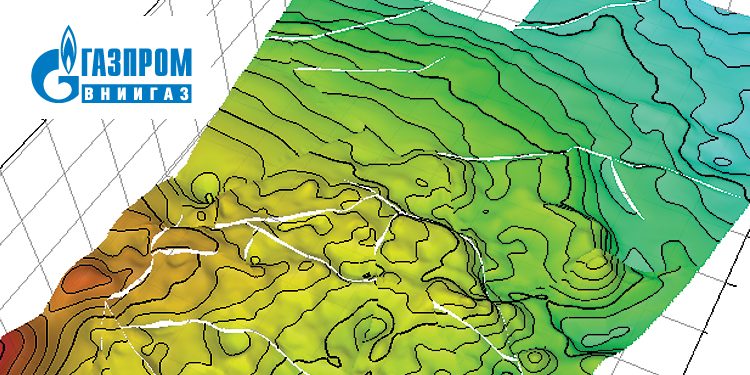Applied and Scientific Solutions, Used for Calculation of Hydrocarbon Reserves in Terrigenous and Carbonate Reservoirs of Basic Gazprom PJSC Fields
Over the last decade, a team of Gazprom VNIIGAZ specialists carried out the estimation of hydrocarbon (HC) reserves, targeting its unique and strategically improtant fields with specific geological-and-technical conditions: the Astrakhan gas-condensate field (carbonate deposits, Petroleum province of the Caspian Sea; Orenburg oil-and-gas condensate field (carbonate deposits, Petroleum province of the Volga-Urals area); Chayandinskoye oil-and-gas condensate field (terrigenous deposits, Petroleum province of the Lena-Vilyui area). The previous estimation of the HC reserves of the Astrakhan and Orenburg fields, not counting any operating stocks, was conducted by a large group of authors back in the 1980’s. The estimation of the HC reserves of the Chayandinskoye oil-and-gas condensate field was approved by the State Reserves Committee under the RF Ministry of Natural Resources in 2000.
A considerable scope of geological exploration has been carried out in the last few decades, which enabled an updated geological and field data model regarding the structure and gas content of targets, which served as the basis for re-estimation of the HC reserves. During this revision the specialists of LLC Gasprom VNIIGAZ managed to resolve a number of scientific and application problems in the period of 2011-2018.
Thus, the technique for determination of oil and gas saturation index and location of gas-water and oil-water contacts zones in the carbonate reservoirs of the Orenburg and Astrakhan fields was refined. For the first time, while carrying out the estimation of the Chayandinskoye field reserves, the porosity factor was determined by acoustic impedance; classification of the area was carried out, with updated core analysis samples and the degree of salinization of the rocks, and the boundary values of the core factor and the permeability of the target horizons were updated; correlations of the contour reserves of HC were revealed, estimated in the intervals of tested targets, with the maximum values of gas flow rates achieved accounting for skin-factor, which makes it possible to predict the flow rates of the step-out wells.
The research, thus carried out, made it possible to provide a rationale for the unprecedented long and stable yield of the Astrakhan field and, correspondingly, of the Astrakhan Gas Chemical Complex. The estimation of the reserves of the Orenburg field, within the boundaries of the Petroleum Province of the Volga-and-Urals area, would make it possible to optimize the design solutions related to its development and construction at the time of production decline. The expeditious estimation of the HC reserves of the Chayandinskoye field enabled the timely project management of its development and construction, as well as confident planning of the volumes and composition of the country’s export gas.
Over the last decade, a team of Gazprom VNIIGAZ specialists carried out the estimation of hydrocarbon (HC) reserves of the country’s strategic giant oil fields, located in different regions of Russia, featured with specific geological and engineering data. The accumulations in the carbonate deposits of the Caspian Sea and the Volga-and-Urals basin were examined, and namely the Astrakhan gas condensate field and the Orenburg oil-gas condensate field, as well as the accumulations in the terrigenous suite venda of the Eastern Siberia, namely, the Chayandinskoye oil-gas condensate field (Fig.1). The fields are unique by both the amount of their HC reserves, and from the point of view of their geological position.

The Chayanovskoye oil-gas condensate field is featured with abnormally low formation pressure and temperature, fault tectonics, presence of a permafrost zone, as well as halite acting as a bonding material for the rocks, high mineralization of edge waters, extensive area of oil rims (with their moderate-size depths), a peculiar composition of formation gases (nitrogen concentration in the formation gas is 7…10% vol., that of helium is 0,44…0,57% vol.) Besides, the underdeveloped industrial, energy and the transport infrastructure of the Republic of Sakha (Yakutia), the shortage of production forces, deeply continental climate (extremely low winter temperatures up to minus
60 °С, and high summer ones up to +35 °С) complicate the execution of works at the field.
The Astrakhan gas condensate field and the Orenburg oil-gas condensate field, on the contrary, are located in the areas with widely spread and developed industrial infrastructure, they have been developed for significantly time period (24 and 44 years, correspondingly) and serve as a raw resource base for Gas Chemical Complexes created on their basis, which include facilities of oil production and treatment, as well as gas processing plants. The Astrakhan gas condensate field is featured with abnormally high values of formation pressure and temperature, very deep position of the productive strata, occurrence of the salt-dome tectonics, heterogeneous and low permeable carbonate reservoir rock, specific composition of gas. The concentration of sour components of the formation gas amounts to 40%. The Orenburg oil-gas condensate field is in an the area with widely spread oil-and-gas bearing formations, both by the area and cross-section, and is by itself a multi-layer formation mass ranging from Lower Permian through Devonian-Mid-Carboniferous deposits. The field, great in its size, is divided by three solid sections (domes) in accordance with its geotectonic structure – the Western, the Central, and the Eastern parts, in what connection the latter is featured with complex fault tectonics. The reservoirs are represented with carbonate rocks, just like at the Astrakhan gas condensate field as well, and featured with heterogeneity and low permeability. The compositional analysis of gas is considerably extensive and unsteady.
Previous the estimation of the hydrocarbon reserves at the Astrakhan and the Orenburg oil-gas condensate fields was carried out during the Soviet era yet, in the 80’s; the estimation of the reserves at the Chayanovskoye oil-gas condensate field was approved by the State Reserves Committee under the RF Ministry of Natural Resources in 2000. The estimation of reserves was carried out by a large group of authors, composed of the leading Russian geologists G.A.Gabielyants, Ya.N.Basin, V.I. Petersils, G.Kh.Sherman, V.I.Poroskun, E.E.Polyakov, Yu.M.Kuteyev, V.M.Ryabov and others, as well as well-known specialists in the field of geology of the Eastern Siberia: V.D.Matveyev, N.I.Koval’, M.M.Soloshchak, G.V.Tolmacheva, L.D.Kolotushchenko, L.A.Kondratyeva and others.
Over the last decades, a significant scope of exploration works has been carried out at the fields (2D and 3D seismic surveys, 49 new expendable wells drilled at Chayanovskoye oil-gas condensate field, active development drilling was performed at the Astrakhan gas condensate field and the Orenburg oil-gas condensate field), in the course of which new geological-geophysical and field data were obtained regarding the structure and gas content of the fields, which served as the basis for re-estimation of the reserves of the fields, performed by the team of Gasprom VNIIGAZ in the period of 2011-2018. The authors of the given piece of work were solving scientific problems directly in the course of the estimation (re-estimation) of the HC reserves at the above mentioned fields. The constructed geological models and the estimation data related to the Astrakhan gas condensate field and the Orenburg oil-gas condensate field were approved the State Reserves Committee under the RF Ministry of Natural Resources (2014 and 2015). The approval of the estimated reserves of the Orenburg oil-gas condensate field is expected in 2019.
The estimation of reserves in terrigenous and carbonate reservoirs, carried out in accordance with commonly known methods, has some peculiarities in terms of the scope of works, especially in terms of the interpretation of the logging data, which need to be adapted to core selection in the specific cross-sections.
The Approach, Applied for Conditions of the Astrakhan Gas Condensate Field
The pay section of the Astrakhan gas condensate field is presented with the carbonate deposits of the Bashkirian stage of the Mid-Carboniferous period in the volume of the upper substage, Prikamsky, Severokeltmensky and Krasnopolyansky horizons of the lower substage. The cross-section is composed of limestones of grey, grey-brown or brown-grey color, of solid, porous and massive formations, blind joint, with tributary interlayers of compact crumbling and tabulated variations. The limestones contain thin lamines of olive-grey flaglike argillites.
According to the core analyses, the values of the effective porosity of the carbonate rocks vary from 3…6 to 15…18 %, making the average of about 10 %. The values of the absolute permeability are not high: from 2 to 100 mD, hardly ever up to 1D.
As is known, the data of electrical logging serve as the basis for quantitative and qualitative evaluation of hydrocarbon saturation. A set of methods, making it possible to solve the task of evaluation of electrical resistivity of pay zones includes lateral electrical sounding, borehole logging, carried out with the use of focused sondes in versions of БК-3 (BK-3) and БКС-2 (BKS-2), inductive electromagnetic logging. Theexamined cross-sections of the carbonate deposits of the Astrakhan gas condensate field are featured with high degree of differentiation on the electric resistivity, while the depth of the electrically homogenous strata does not exceed 2…3 m. therefore, the application of lateral electrical sounding for this purpose is becoming practically impossible. Considering the limitations of inductive electromagnetic logging to evaluate resistance exceeding 30…40 Om-m, the use of the method for large-scale measurements of resistivity is excluded as well. Therefore, the only usable method for the outlined task is lateral logging in versions of BK-3 and BKS-2, or more updated versions of BK-7, BK-9.
Due to the above mentioned drawbacks of the methods to evaluate the electrical resistivity of reservoirs in wells based on measurements performed with dual logging BKS-2 [1], carried out in the process of previous estimation of reserves, to evaluate the electrical resistivity, it was suggested to apply the method based on obtaining correlations of electrical resistivity and conventional resistance. As a result of this, an algorithm of evaluation of electrical resistivity and an initial gas saturation was obtained on all of the drilled wells.
A feature, peculiar to the structural position of the reservoir’s basic deposit of the Left Bank part of the Astrakhan gas condensate field is swinging and an unstable position of the gas-water contact surface, which, in accordance with the criteria of the State Reserves Committee under the RF Ministry of Natural Resources, bounces off at the values under 50%. As is known, under such conditions there is undoubtedly the so called “transition zone”, i.e. gradual transition from the water-saturated part of deposit to its gas-saturated one. [1] The primary task (before the contacts get explained, including the GWC) in this situation is to determine the position of the gravity water, while the value of gas saturation in the transition zone is determined by the equilibrium of the capillary and gravitational forces related to contacted stages above the level of the gravity water. [1].
The data of interpretation and re-interpretation of the well logging materials at the Left Bank part of the Astrakhan gas condensate field, obtained in the course of the latest research, made it possible to update the knowledge of the complex gas-water contact surface, as well as, by means of analysis of the “electrical model” (data of electrical logging) to determine its correlation by the area with the surface of gravity water [see fig.4]. As one of the criteria, applied during the determination of the position of GWC, the evaluation of the degree of variation of the gas saturation coefficient along the depth [1].
The map of GWC surface, built on the actual well logging data, and run-ups not having contradictory data on the formation pressures in the gas- and water-saturated parts of the deposit, generally confirms the previously revealed trend of elevations decreasing in the south-westerly direction, against the background of which local zones of higher and lower values of theirs stand out.
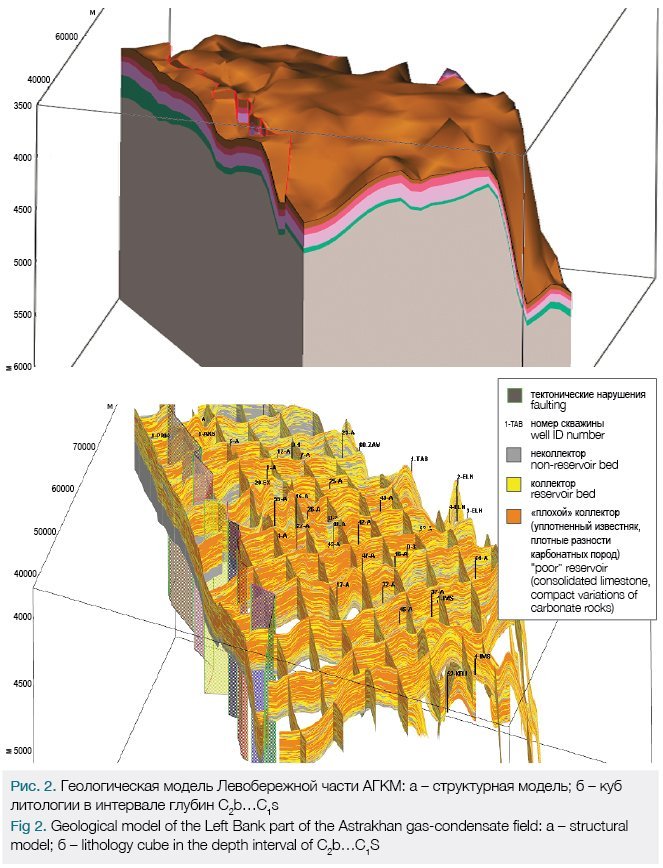
Therefore, the authors have suggested a number of innovation solutions to defend the variables used to estimate reserves and a 3D digital geological model of the Left Bank part of the Astrakhan gas condensate field was built for the first time, with account of updated data (fig.2), on whose basis re-estimation of reserves was carried out for non-associated gas, condensate, sulfur and associated components, which, undoubtedly, is actual for secure development of the mineral resource base of the Astrakhan Gas Chemical Complex in the Southern Russia. As a result of the performed re-estimation, addition to commercial reserves of non-associated gas of the C2b pay zone at the Left Bank part of the Astrakhan gas condensate field was received, exceeding 20% due to updated data on the structure plan, based on the data obtained from the performed 3D seismic survey and drilling new wells, and due to updated data o the GWC surface, but largely at the expense of increased values of the average effective porosity and gas saturation.
Approach, Applied for Conditions of the Orenburg Oil-and-Gas Condensate Field
The pay zone of the Orenburg oil-and-gas condensate field is attributed to the carbonate type includes the following lithologic variations: straight limestones, dolomite limestones, with changing interlayers, having properties of reservoirs and non-reservoirs; argillites and clays. One of the features of the cross-section is bituminosity of rocks. Limestones with interstitial type of porosity serve as reservoirs in the examined cross-section.
The average values of the core porosity range within the values of 8,82…17,57%. Weighted mean values of porosity make up 11,21…11,73% (for different deposit occurences). The average permeability across the occurencies made up from 0,331 mD (Artinsk-Sakmarsky deposit) to 1,923 mD (Mid-Carboniferous deposit).
Minding the given conditions, it is practically impossible to achieve an unambiguous determination of oil-gas saturation, using lateral log and core data as the base method. Comparison of the values of oil saturation factor (Ko), determined through the standard method, with the use of lateral log and core data, and with the use of indirect and direct methods of determination of the residual water saturation, shows that the actual cause of the maximum dispersion and offset towards elevated values of Ko, obtained from the lateral log data, is the factor of bituminosity and hydrophobic properties of the whole cross-section. Undervalues of Ko, to a lesser degree, but nevertheless significantly, are conditioned with the fractured type of the cross-section in the whole range of porosity. Search for geotechnical conditions to improve the informativeness of the lateral log, for the evaluation of the hydrocarbon saturation, actually did not have any success.
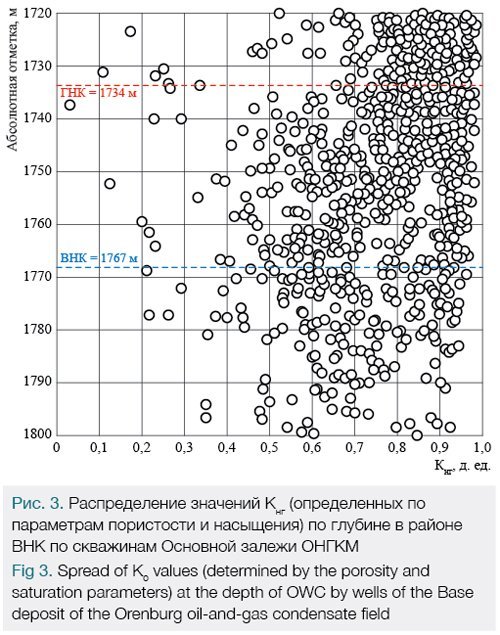
Fig.3 has the spread of values in the area of elevations of the gas-oil (GOC) and oil-water (OWC) contacts, which lead to unambiguous conclusion that there is no variation of Ko values of reservoirs, determined on the basis of lateral log data, at the points of transition from gas saturated cross-section to water saturated and oil saturated ones. Similar data are obtained regarding the spread of the electrical resistivity values, which were determined based on the lateral log data, in water and oil, built for the reservoirs of the base deposit of the Orenburg oil-and-gas condensate field (Fig.4).
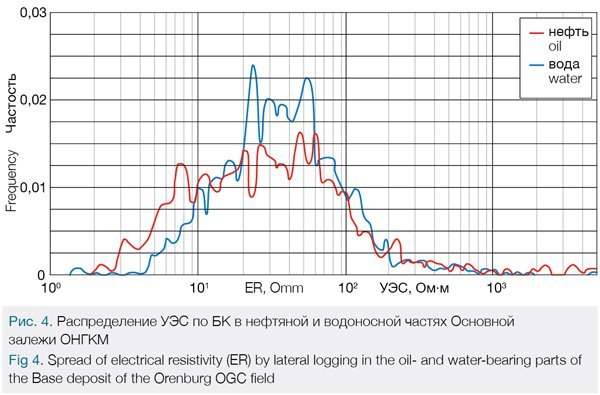
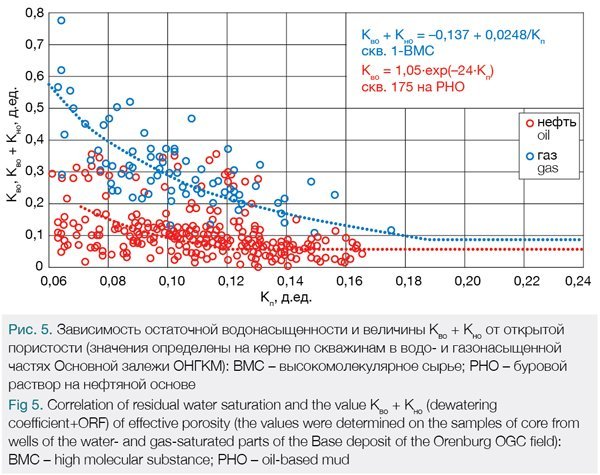
Due to the fact that the lateral log data in the cross-section of wells at the Orenburg oil-and-gas condensate field do not make it possible to unambiguously determine the nature of saturation and oil-gas saturation, to alternatively determine the latter, a method was developed based on the data of core analysis, well logging (induced gamma-ray logging) and the statistical evaluation of the results of tests, based on the petrophysical model, resulting from correlation of residual water saturation of non-extractable core (Kво) and effective porosity (Kp) (Fig.5). To determine oil saturation in the acrozone of the oil rim (КORF) interpolation was applied to correlation of residual water saturation and porosity, which was obtained on the samples of core, selected from the well drilled by the waterless method (oil-based mud). All the values of the residual oil saturation on the core, which had been ignored in the previous estimation of reserves (over 40% in the interval
К, = 6.. .10 %, over 30% under K=10…12%, over 20% under Кп =12…20%), are related to determination, where liquid bitumens, alongside with oil, were entered. The rock porosity, in the process of sample extraction, carried out by standard method, gets completely clean of residual oil, as well as of the most light and fluent fractions of bitumen, not touching solid bitumen, forming kind of skeleton of the rock. This is also confirmed by the data of special petrophysical research, carried out on small bits of rock, formed during development of standard-size samples (research was carried out in the Petrophysics Department of the Scientific and Production Center “Tvergeofizika”).
Therefore, assumptions on parameters КORF and КWL were confirmed, which enabled us to formulate the algorythm of determination of gas saturation and oil saturation in the ultimate saturation zone (see Fig.5).
The exploratory well test data, for the most of deposits of the Orenburg oil-and-gas condensate field, give evidence of a broad range of ways of production (oil and water) in the interval, including OWC. The test and well test data, related to this interval are contradictory and do not make it possible to unambiguously determine the OWC level. Thus, the presence of transition zone in the oil and water-saturated parts of deposits should be taken into account in the model, just like it was done for the context of the Astrakhan gas condensate field at the «gas-water» interface.
Due to the lack of possibility to build a model of the transition zone, to evaluate it, an approach was applied, based on the results of well logging data interpretation, which was reflected in the methodic recommendations, provided by V.I. Petersils [2] and adapted to conditions of the Orenburg oil-and-gas condensate field. The essence of the method can be defined as the following. First, it is necessary to evaluate the level of the free water level – (FWL ) under which water alone is located. The evaluation of the FWL position was performed based on the data of formation pressures within the oil- and water-saturated parts of the deposit, and was confirmed through statistical data of tests, based on which the depth of transition zone was also evaluated. The evaluation of the depth of transition zone was confirmed through the determination of the values of relative permeability ratio, based on which correlation data for evaluation of residual oil- and gas-saturation were obtained. The depth of OWC position within the area of transition zone was evaluated with the application of results of measurement of capillary pressure on samples, with recalculation of its values for conditions of formation, for fluids oil/water (Fig.6).
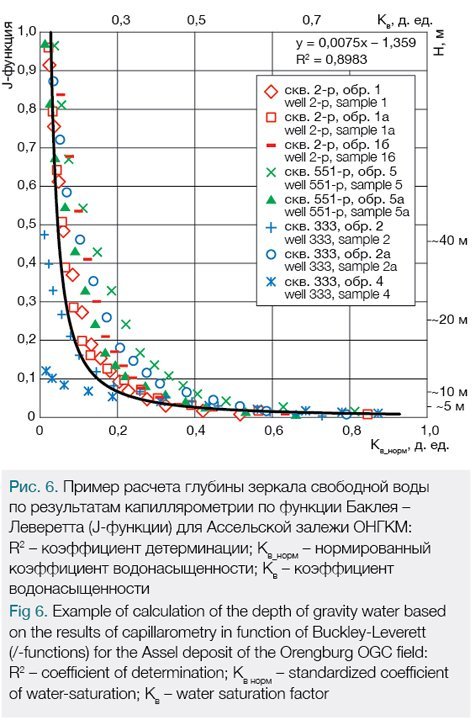
To confirm the level of OWC at the base deposit and Mid-Carboniferous deposit of the Orenburg oil-and-gas condensate field, the method of directed summing of the relative electrical resistivity of reservoir was applied, which makes it possible to use data of the well test, carried out in the interval below the OWC (Fig.7).
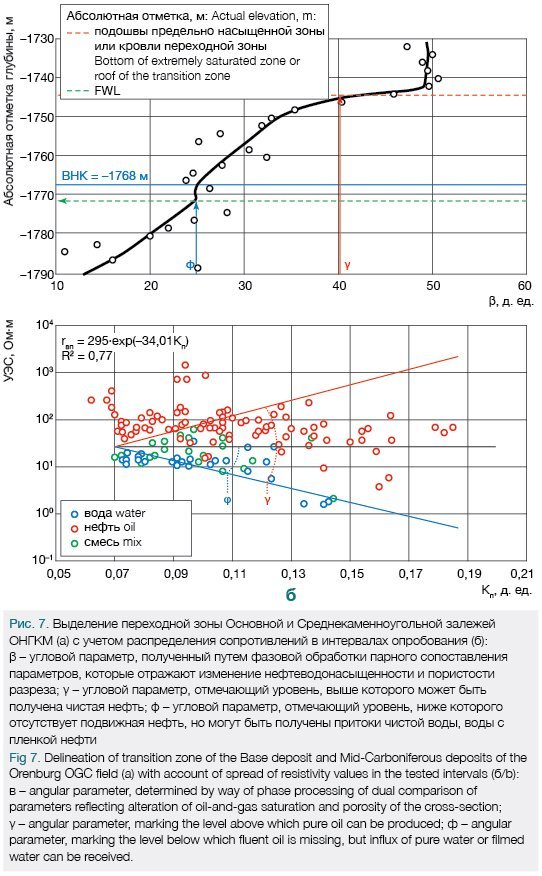
As a result of the analysis and summation of all the accumulated geological and geophysical information, a 3D digital geological model of the whole Orenburg oil-and-gas condensate field was built-up, including the necessary cubes for estimation of reserves (Fig.8). The reserves, practically estimated by volumetric method, in the whole practically agree with the ones evaluated by method of formation pressure decline (difference makes up not more than 1%), which speaks in favour of the optimality of the technological solutions, applied at the Orenburg oil-and-gas condensate field.
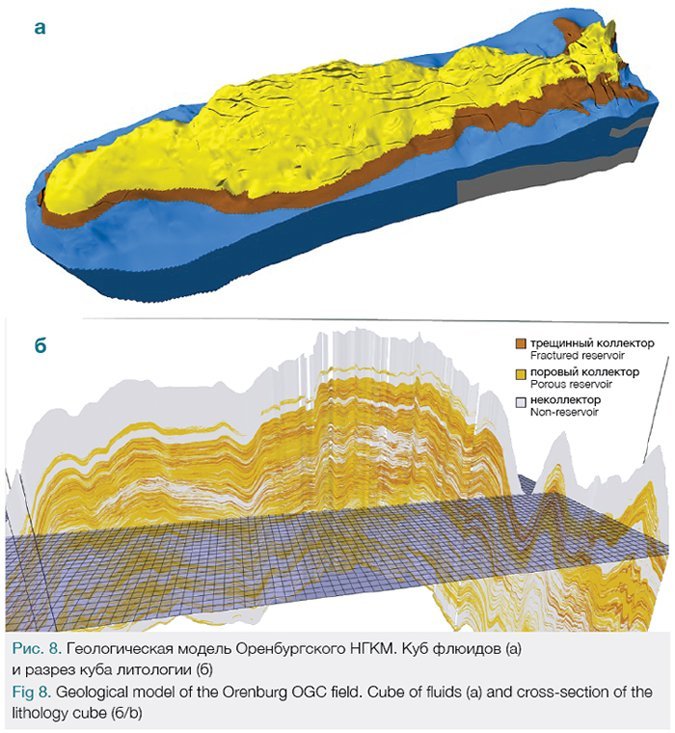
It should be noted that the estimation of HC reserves of the Orenburg oil-and-gas condensate field, carried out by Gazprom VNIIGAZ, contains not only the above mentioned innovative solutions, but alongside with that utilizes previously published works related to the given target, carried out by NPF “Orenburggasgeofizika” (N.A.Ivanova), LLC “VolgoUralNIPIgas” (S.V.Bagmanova, M.A.Politykina and others), JSC “Central Geophysical Expedition (S.I.Bilibin).
Approach, Applied for Conditions of the Chayandinskoye Oil-and-Gas Condensate Field
The cross-section of the Chayandinskoye oil-and-gas condensate field, penetrated by its wells, is represented with carbonate-halogenous, carbonate and sandy-and-clay deposits of Cambrian-venda. The field is multi-layer one, pay zone is represented with terrigenous deposits of venda.
Botuobin horizon is represented with fine- and medium-grained quartz sandstones and siltstones. The rocks of hamakin horizon are mainly represented with fine- and medium- and coarse-grained sandstones with regeneration quartz cement, as well as with unevenly spreaded clotted or clotted-porous sulphate (anhydrite and gypsum) and carbonaceous cement, mixed with carbonaceous-argillaceous and the pore- and film-type argillaceous (hydromica-type) cement. The rocks of talakh horizon are represented with medium-grained, fine-grained, coarse-grained, and very coarse-grained (gravelstone) sandstones with various types of cementation.
The average values of Кp on the core analysis for reservoirs of botuobin, khamakin and talakh horizons made up 0,130, 0,092 and 0,113, correspondingly, and that of permeability –was 356,7, 183,2 and 46,7 mD
For the first time, in the course of estimation of HC reserves of the Chayanovskoye oil-gas condensate field (in 2013, within the botuobin horizon, in 2015-for all the pay zones) Кp was determined by acoustic impedance. Due to impossibility of sufficiently accurate account of oil- and gas-saturation of the near-field zone the data of electrical logging were not used for determination of porosity. Due to the same reason, because of insufficient standardization of the method, the data of neutron logging were not used as well. Thus, the determination of porosity of the botuobin, khamakin and talakh pay zones was implemented with the use of data of acoustic logging and gamma-gamma-density logging, with application of correlations of the “core-to-core” type and “core-to-logging» type.
Integration of the acoustic logging and gamma-gamma-density logging is based on the application of correlations
of acoustic impedance (G), determined as multiplication of the longitudinal wave velocity in the rock and the bulk density of that rock, of porosity. Thus, based on the updated information according to well logging data and core analysis, correlation of G and Кp was corrected for botuobin horizon, and new correlations of “core-to-well logging data” for khamakin and talakh horizons were obtained [see Fig.3] .
Correlations for botuobin horizon were differentiated for gas-saturated and oil- and water-saturated rocks, for khamakin and talakh horizons they were accepted as unified because of insignificant impact of residual gas-saturation in the penetration zone on readings of devices at acoustic logging and gamma-gamma-density logging.
Relating to the wells drilled before 2000, the gamma-gamma-density logging was applied to only 10 of them. In such cases, determination of the Кp value of the rocks was carried out based on the data of acoustic logging with the use of petrophysical correlations of the interval time of elastic waves (At) and Кp, obtained on the core during the modeling of the thermobaric conditions of formation and confirmed by the “core-to-logging” data [see Fig.4]. Correlations for botuobin horizon were differentiated for clean (dJYK < 0,25) and argillaceous (dJ^ > 0,25) reservoirs, where dJYK is double gamma-ray index of the gamma logging.
The account of clay content for reservoirs of kahamin horizon is achieved through entering the dJYK parameter into the equation. For alternations (gravelites), more often deposited in the upper part of the khamakin horizon and featured with abnormally high values of gamma-logging, not related to clay content, the determination of porosity was carried out based on correlation “core-to-core” obtained in the course of modeling of formation conditions. The readings of gamma-logging, in the deposits of the talakh horizon, are not only controlled by clay content, but largely by mineral composition of rocks, that is why the account of clay content, while determining the porosity ratio by acoustic logging, was not done.
In the course of integrated logging data processing, determination of Кp values of rocks by the data of gamma-gamma-density logging was carried out as well, with the use of petrophysical functions, corresponding to each pay zone. Taking into account low linkage of Кp, determined by variations of the mineral composition, the values of Кp by gamma-gamma-density analysis were used in an estimative mode. The values of Кp by G, and in case of missing gamma-gamma-density logging, – the values of K by acoustic logging, were accepted as resulting data, provided the availability of the gamma-gamma-density logging data in the complex of well logging data. On the basis of integration of all the geological and geophysical information a 3D geological digital model was built-up for the Chayanovskoye oil-gas condensate field for all the 3 pay zones (Fig.9), on the basis of which a team of geologists of Gazprom VNIIGAZ (under direction of E.E.Polyakov), with participation of specialists of the branch in Ukhta (under direction of N.P.Visheratina), as well as LLC «TsNIP GIS” (L.A.Kondratyeva, L.D.Kolotushchenko, V.Yu.Trukhin, T.A.Votyakova), LLC “Gasprom Geologorazvedka” (A.A.Kontorovich, I.V.Korsunov), LLC “Ingeoservis” (under direction of O.A.Smirnov) the estimation of HC reserves has been carried out. Formation productivity of the above positioned Osin horizon was estimated as non-commercial.

Besides, the following major conclusions were made, based on the results of research, carried out at the Chayanovskoye oil-gas condensate field:
1) Based on the results of exploration works, the picture of tectonic structure of the Chayanovskoye oil-gas condensate field was significantly updated – 19 isolated tectonic blocks were delineated with due justification. (before only four basic blocks were delineated);
2) With account of updated core analysis data and the information about the degree of salinisation of rocks, zoning of the territory was carried out and boundary values of the porosity ratio and permeability of pay zones were updated for the Chayanovskoye oil-gas condensate field;
3) The contour reserves of HC, estimated in the intervals of tested targets are well correlated with the maximum values of obtained gas rates, with account of skin-effect value, which makes it possible to predict the production rates at the step-out wells.
Therefore, the detailed investigations of the geological structure of the strategic and significant gas-containing targets, with consequent estimation of the HC reserves makes it possible to predict the development perspectives of the mineral resource base of both PJSC “Gasprom”, and of the whole Russia, as well as the export potential of the country.
The research, carried out in the Petroleum province of the Caspian Sea, made it possible to provide rationale for the unprecedented long and stable yield of the Astrakhan gas-condensate field and, correspondingly, of the Astrakhan Gas Chemical Complex.
The results of the reserves estimation, within the boundaries of the Petroleum province of the Volga-Urals area, will make it possible to optimize design solutions in terms of development and construction of the Orenburg oil-and-gas condensate field at the times of its declining production.
The estimation of reserves of the Chayanovskoye oil-gas condensate field of the Petroleum province of Lena-Tunguss area (is included in the zone of primary development in the area of the active crude pipeline “Eastern Siberia – the Pacific ocean” and projected pipeline “The Power of Siberia”) carried out under tight schedule, made it possible to timely implement project engineering of development and construction of the field, as well as substantially plan the volumes and composition of the country’s export gas.
References
1. POLYAKOV, Ye.Ye., Ye.A. FEDOROVA, V.V. STREKOZIN et al. Solving scientifi c tasks at calculation of hydrocarbon reserves in Astrakhan gascondensate fi eld [Resheniye nauchnykh problem pri podschete zapasov uglevodorodov Astrakhanskogo gazokondensatnogo mestorozhdeniya]. Vesti Gazovoy Nauki: collected scientific technical papers. Moscow: Gazprom VNIIGAZ LLC, 2017, no. 3 (31): Issues for resource provision of gas-extractive regions of Russia, pp. 141–150. ISSN 2306-9849. (Russ.).
2. Guidelines on calculation of geological reserves of oil and gas using a volumetric procedure [Metodicheskiye rekomendatsii po podschetu geologicheskikh zapasov nefti i gaza obyemnym metodom]. Moscow: All-Russian Research Geological Oil Institute (VNIGNI); Tver: NPTs “Tvergeofi zika”, 2003. (Russ.).
3. POLYAKOV, Ye.Ye., A.Ye. RYZHOV, O.V. IVCHENKO et al. Scientifi c tasks solved at calculating hydrocarbon reserves of Chayanda oil-gascondensate field [Resheniye nauchnykh problem pri podschete zapasov uglevodorodov Chayandinskogo neftegazokondensatnogo mestorozhdeniya]. Vesti Gazovoy Nauki: collected scientifi c technical papers. Moscow: Gazprom VNIIGAZ LLC, 2017, no. 3 (31): Issues for resource provision of gas-extractive regions of Russia, pp. 172–186. ISSN 2306-9849. (Russ.).
Ye.Ye. Polyakov1, Ye.A. Fedorova1, V.V. Strekozin1, I.V. Churikova1, K.M. Semenova1, N.A. Nikulnikova1, S.Yu. Romashchenko1, A.G. Yefimov2, S.M. Poberezhskiy2, A.S. Kolubayev2, A.Yu. Komarov3, V.A Zakharchuk3
1 Gazprom VNIIGAZ LLC, Bld. 1, Estate 15, Proyektiruemyy proezd no. 5537, Razvilka village, Leninsky district, Moscow Region, 142717, Russian Federation
2 Gazprom Dobycha Orenburg LLC, Bld. 1/2, Chkalova street, Orenburg, 460058, Russian Federation
3 Gazprom Dobycha Astrakhan LLC, Bld. 30, Lenina street, Astrakhan, 414000, Russian Federation
The original article was first published in the «Vesti Gazovoy Nauki» scientific journal no. 3, 2018.
Published with thanks to the Gazprom VNIIGAZ LLC.

